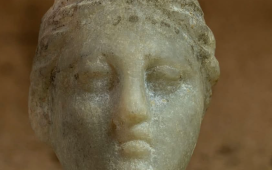[ad_1]
The massive asteroid that brought about the end of the reign of the dinosaurs when it crashed into Earth 66m years ago was not a one-off, researchers say.
Detailed scans of an underwater crater off the coast of Guinea in West Africa suggest that it was created when another large asteroid smashed into the planet around the same time at the end of the Cretaceous period.
The violent impact between 65m and 67m years ago produced a crater more than five miles across, the scans reveal, with scientists estimating that the asteroid measured a quarter of a mile wide and struck Earth at nearly 45,000mph.
Though smaller than the asteroid that sparked the mass extinction, it was still large enough to leave scars on the face of the planet. “The new images paint a picture of the catastrophic event,” said Dr Uisdean Nicholson, a marine geologist at Heriot-Watt University in Edinburgh, who first discovered the Nadir crater in 2022. At the time, the details of the impact were unclear.
To understand more about the impact, the scientists used 3D seismic imaging to map the crater rim and geological scars that lie 300 metres beneath the ocean floor. “There are around 20 confirmed marine craters worldwide, and none of them has been captured in anything close to this level of detail,” said Nicholson. “It’s exquisite.”
The collision appeared to have set off intense tremors that liquefied sediments beneath the ocean floor causing faults to form below the seabed, the researchers found. The impact triggered landslides with traces of damage visible for thousands of square miles beyond the crater rim, and unleashed a vast tsunami more than 800metres high that would have travelled across the Atlantic. Details are published in Nature Communications Earth & Environment.
The researchers cannot pinpoint when the asteroid struck Earth, but the discovery of the crater and its approximate age have prompted speculation that it may have belonged to a cluster of impacts at the end of the Cretaceous period. The asteroid linked to the extinction of the dinosaurs was far larger than the rock that produced the Nadir crater. It left a crater 100 miles wide in what is now Chicxulub on the Yucatan peninsula in Mexico.
“The closest humans have come to seeing something like this is the 1908 Tunguska event, when a 50-metre asteroid entered Earth’s atmosphere and exploded in the skies above Siberia,” Nicholson said. “The new 3D seismic data across the whole Nadir crater is an unprecedented opportunity to test impact crater hypotheses, develop new models of crater formation in the marine environment and understand the consequences of such an event.”
[ad_2]
READ SOURCE













